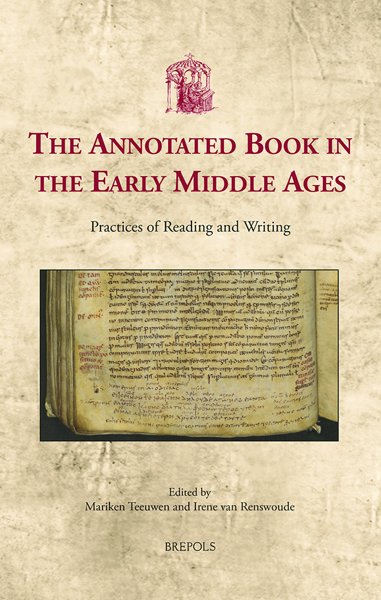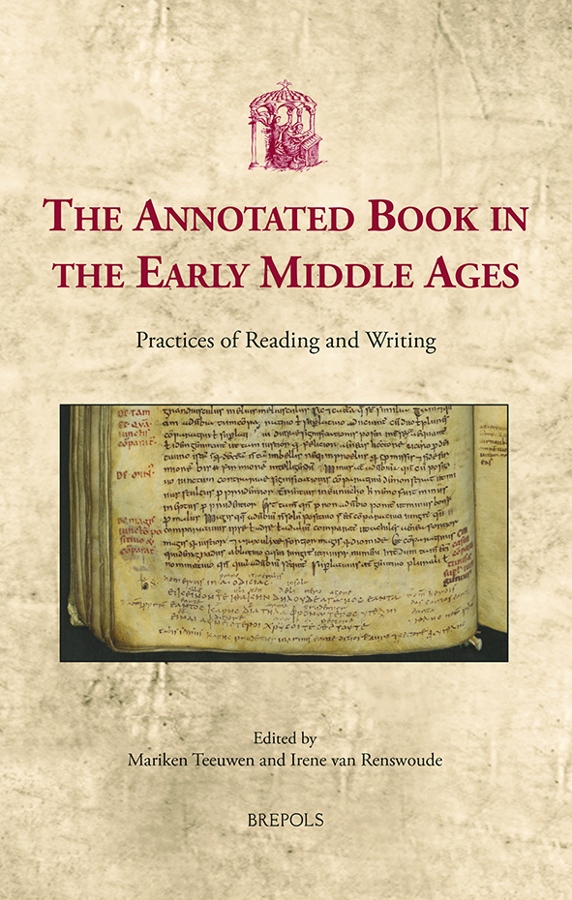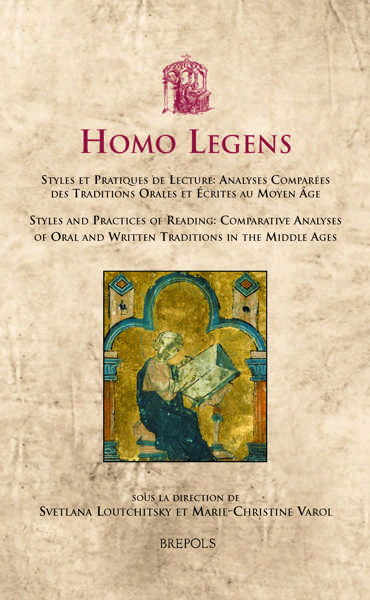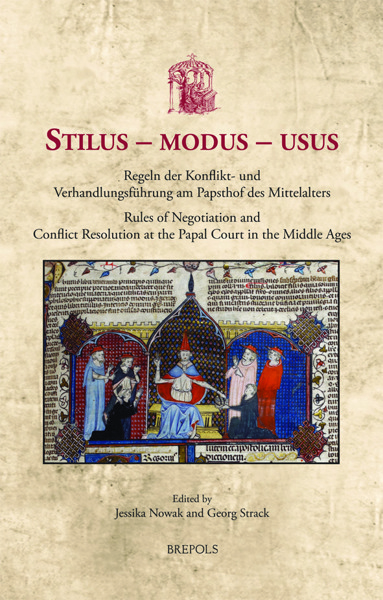
The Annotated Book in the Early Middle Ages
Practices of Reading and Writing
Mariken Teeuwen, Irene van Renswoude (eds)
- Pages: xii + 783 p.
- Size:156 x 234 mm
- Illustrations:41 b/w
- Language(s):English, German, French
- Publication Year:2018
- € 155,00 EXCL. VAT RETAIL PRICE
- ISBN: 978-2-503-56948-2
- Hardback
- Available
- € 155,00 EXCL. VAT RETAIL PRICE
- ISBN: 978-2-503-56949-9
- E-book
- Available
A collection of essays exploring annotation and scholarly practice in early medieval manuscripts
“The Annotated Book is a pioneering collection that will be cited for years and, best of all, produce even more work.” (John J. Contreni, in The Medieval Review, 18.12.07)
“This substantial contribution represents a major outcome of the multi-year and multifaceted Marginal Scholarship project (…)The essays will undoubtedly serve as valuable references and open new avenues of research in the rich area of annotations and marginal scholarship.” (Christine E. Bachman, in Manuscript Sudies, 4/2, 2019, p. 429-432)
“This impressive and remarkable volume constitutes a compendium that cannot be ignored by scholars working on marginalia, but it offers more generally some very interesting perspectives on the field of cultural studies, in particular on the evolution of books’ uses and of their audiences across time. The case studies presented shed light on intellectual life in the early Middle Ages by showing how medieval scholars received, studied, discussed, or reshaped texts, while annotations or paratexts are in some instances the only indications left of such activities. They are precious indicators of the multiple readings and functions of texts, of the subsequent uses made of them, and particularly of individual and collective practices of reading and learning (Micol Long, Cinzia Grifoni).” (Gaelle Bosseman, in Parergon, 37/1, 2020, p. 290)
Annotations in modern books are a phenomenon that often causes disapproval: we are not supposed to draw, doodle, underline, or highlight in our books. In many medieval manuscripts, however, the pages are filled with annotations around the text and in-between the lines. In some cases, a ‘white space’ around the text is even laid out to contain extra text, pricked and ruled for the purpose. Just as footnotes are an approved and standard part of the modern academic book, so the flyleaves, margins, and interlinear spaces of many medieval manuscripts are an invitation to add extra text.
This volume focuses on annotation in the early medieval period. In treating manuscripts as mirrors of the medieval minds who created them – reflecting their interests, their choices, their practices – the essays explore a number of key topics. Are there certain genres in which the making of annotations seems to be more appropriate or common than in others? Are there genres in which annotating is ‘not done’? Are there certain monastic centres in which annotating practices flourish, and from which they spread?
The volume investigates whether early medieval annotators used specific techniques, perhaps identifiable with their scribal communities or schools. It explores what annotators actually sought to accomplish with their annotations, and how the techniques of annotating developed over time and per region.
Abbreviations
List of Illustrations
Introduction – MARIKEN TEEUWEN and IRENE VAN RENSWOUDE
Section I: Scholars and Their Books: Practices and Methods of Annotating
Voices from the Edge: Annotating Books in the Carolingian Period – MARIKEN TEEUWEN
Technical Signs in Early Medieval Manuscripts Copied in Irish Minuscle – EVINA STEINOVÁ
A Peregrinus’s Vade Mecum: MS Bern 363 and the ‘Circle of Sedulius Scottus’ – GIORGIA VOCINO
The Making of the De praedestinatione of Ratramnus of Corbie (Including the Identification of a New Personal Manuscript) – WARREN PEZÉ
The Making of a Tenth-Century Self-Commentary: The Glosses to Atto of Vercelli’s Perpendiculum and Their Sources – GIACOMO VIGNODELLI
Section II: Textual Scholarship by Means of Annotation
The Earliest Anonymous Exposition of Priscian: Two Manuscripts and Their Glosses – FRANCK CINATO
Source Marks in Scholia: Evidence from an Early Medieval Gospel Manuscript – MARKUS SCHIEGG
Tironische Tituli: Die Verwendung stenographischer Marginalien zur inhaltlichen Erschließung von Texten des frühen Mittelalters – MARTIN HELLMANN
Glossen aus einem einzigen Buchstaben – ANDREAS NIEVERGELT
Space as Paratext: Scribal Practice in the Medieval Edition of Ammianus Marcellinus – JUSTIN STOVER
The Margin as Editorial Space: Upgrading Dioscorides alphabeticus in Eleventh-Century Monte Cassino – ERIK KWAKKEL
Making notae for Scholarly Retrieval: A Franciscan Case Study – ALBERTO CEVOLINI
Section III: Private Study and Classroom Reading
Reading and the Lemma in Early Medieval Textual Culture – SINÉAD O’SULLIVAN
Reading between the Lines of Virgil’s Early Medieval Manuscripts – SILVIA OTTAVIANO
Notker Labeo’s Translation / Commentaries: Changing Form and Function over Time – ANNA GROTANS
Transmitting Knowledge by Text and Illustration: The Case of MS Leiden, UB, VLO 15 – AD VAN ELS 465
Monastic Practices of Shared Reading as Means of Learning – MICOL LONG
Reading Horace alongside Other Classics: MS British Library, Harley 2724 – PAULINA TARASKIN
Section IV: Annotating Orthodox and Heterodox Knowledge
The Censor’s Rod: Textual Criticism, Judgment, and Canon Formation in Late Antiquity and the Early Middle Ages – IRENE VAN RENSWOUDE
Text and Context: The Annotations in MS Verona, Biblioteca Capitolare XXII (20) – LUCIANA CUPPO
Studying Jerome in a Carolingian Monastery – JANNEKE RAAIJMAKERS
Deux témoins d’Ambroise sur le Psaume 118 et leur ancêtre – PIERRE CHAMBERT-PROTAT
The Annotation of Patristic Texts as Curatorial Activity? The Case of Marginalia to Augustine’s De Genesi ad litteram in Late Antiquity and the Middle Ages – JESSE KESKIAHO
Reading the Catholic Epistles: Glossing Practices in Early Medieval Wissembourg – CINZIA GRIFONI
Theological Issues and Traces of Controversies in Manuscripts Transmitting Works of the Church Fathers – PATRIZIA CARMASSI
Epilogue
The Search for Glossed Clauses: An Autobiographical Account of a Corbie Study – DAVID GANZ
Indices




